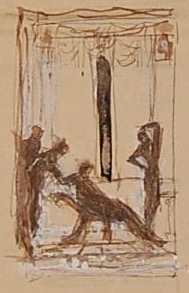The sheet containing the five sketches for the illustrations in Unrecorded Histories (British Museum collection) does not include one for the story ‘The Pavilion of the Winds’ about Solomon and the Queen of Sheba.
The fifth and final sketch is for another story, 'The Last Guest', which takes place in the house of Lepidus, a friend of Caesar. As in the previous story ('A Morning in Spring'), Caesar's imminent death plays a role, in this case he appears at the house of his friend, the evening before he is murdered.
This - the approaching, inevitable death - was clearly a subject that fascinated Ricketts. He often painted figures shortly before or after the ultimate moment: Montezuma, Christ, Cleopatra, Don Juan and others, time and time again.
The basic premise of this story is Ricketts' idea that historians have placed too much emphasis on Caesar as a military leader and politician and have forgotten 'the art and beauty-loving Caesar who wrote epigrams and plays'.
 |
| Charles Ricketts, 'The Last Guest' |
The uncultured host has gathered a motley company of businessmen, orators and poets, some of whom are of Greek origin, such as Agathon. A separate table is set for Caesar so that he can continue his work as a statesman during the meal and the discussions (dictating a letter, listening to a messenger). However, though the meal is progressing, Caesar has not yet arrived.
Agathon talks about the effect of thunder on the growth of truffles, which are said to be half animal and half plant. Many of the guests eagerly speculate on this topic. The doctor in the company responds soberly:
Be the truffle animal or vegetable, I think that storms, by their torrential rain, merely uncover their hiding place without need of intervention from the thunderbolts of Zeus.
The doctor seems to be the voice of Ricketts, who speaks about ageing:
[...] age calms the force of our passions, even the passion of love; how much more does it affect our power to hate! which experience of life commonly softens. [...] I even hold that old enemies may sometimes be preferable to new friends.
Ricketts, who in his youth had declared many artists and critics his enemies, later realised that these 'frenemies' were perhaps closer to him than others.
During the conversation about friendship and love - ('Let a youth acquire knowledge of the pleasures of the bed from a young boy slave, this saves him from the snares of venal harlots [...]'), - Caesar quietly enters.
 |
| Charles Ricketts, sketch for Unrecorded Histories [Collection British Museum: 1946,0209.122] [Creative Commons Attribution-NonCommercial-ShareAlike 4.0 International (CC BY-NC-SA 4.0) license] [© With permission of the executors of the Charles Ricketts estate, Leonie Sturge-Moore and the heirs of Charmain O'Neil] |
The illustration shows his arrival, or, perhaps his later departure.
The Emperor paused to hear; then, with a salutation of the hand towards his host and fellow guests, he sank upon his couch and chose some simple food from the onyx table before him.
The physician wondered, 'how long would Caesar have to live', because of his 'transparent hands' and his thinning hair. However, his eyes 'had a fixed inner light like the glance of a hawk'.
The discussion continues about the soul, and the physician says that the soul is part of the body and cannot live on its own. Meanwhile, Caesar silently responds to several messages, including one from his wife, who is worried because of the late hour and a prophetic dream about the Ides of March.
The lateness of the hour, and something disquieting in the behaviour of the Emperor had affected the guests [...]
No wonder, because some of the guests were in on the plot to kill him.
After the physician repeats his opinion - 'To me the Soul can never be immortal, it dies with the brain' - the discussion turns to death.
Suddenly Caesar stands up and as he leaves, his host asks him what he thinks is the best way to die. His words end the story:
The Swiftest, the most unforeseen!







.jpeg)
.jpeg)